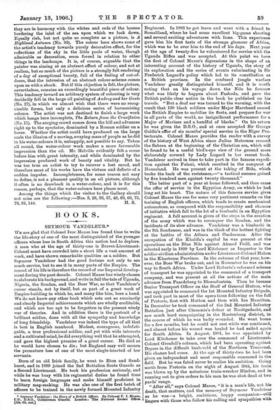THE WORKS OF ARTHUR MELVILLE AT THE INSTITUTE.
A. COLLECTION of a painter's work when he has been stopped in mid-career has always a feeling of sadness in it. Especially is this the case if, as here, the painter's powers were vigorous to the end. It is possible to prefer the work done in the artist's early maturity, and at the same time acknowledge that the later development was full of force,—perhaps making for some end which was unhappily never to be reached.
Above all things, Mr. Melville was a painter of crowds. Massed humanity at a bull-fight under the glare of the Southern sun, or the stream of life in Oriental cities, were favourite subjects with the painter, and with them he succeeded. He drew not so much the individuals of the crowd, but the crowd itself as an entity. Through all the transitions of gorgeous colour and startling light and shade the impression of the mass as a whole is maintained. As examples of this may be instanced The Fête of the Dosseh (No. 59) and Bravo Toro (No. 91). Indeed, so vivid is the effect of the latter, that while looking at it we seem to be listening to the music of the last act of Carmen.
The water-colour work of this artist was remarkable for the great depth and strength of its colour. Indeed, it is difficult to imagine the resources of the medium being pushed further in the direction of brilliancy and richness than in The Sapphire Sea (No. 81). Sea and sky alike are of intense colour, but
they are in harmony with the whites and reds of the houses bordering the inlet of the sea upon which we look down., Equally rich, but not quite so complete as a picture, is A. Highland Autumn (No. 93). The colour here shows some of the artist's tendency towards purely decorative effect, for the reflections of the sky in the little pools of water, though admirable as decoration, seem forced in relation to other things in the landscape. It is, of course, arguable that the painter was aiming at an abstract effect of colour, and not at realism, but so much of the picture is a strongly felt rendering of a day of exceptional beauty, full of the feeling of out-of- doors, that the intrusion of an abstract colour-scheme comes upon us with a shock. But if this objection is felt, the picture, nevertheless, remains an exceedingly beautiful piece of colour. This tendency toward an arbitrary system of colouring is very decidedly felt in the large oil painting of Audrey and her Goats (No. 27), in which we almost wish that there were no recog- nisable forms, but only a delicious series of harmonising colours. The artist was not destined to finish a large work which hangs here incomplete, The Return from the Crucifixion (No. 15). The surging crowd comes down the hill and advances right up to the spectator, dominated by a Roman soldier on a horse. Whether the artist could have produced on the large scale the illusion of a moving, swaying mass of people as he did in his water-colours it is, unhappily, not possible to say. Taken all round, the water-colour work makes a more favourable impression than the oil. Mr. Melville evidently felt a scene before him with great intensity, and while dominated by the impression produced work of beauty and vitality. But he was too true an artist to try to recover a lost mood, and therefore most of his works have the virtues and defects of a sudden impulse. Incompleteness, for some reason not easy to define, is not a pleasant quality in an oil picture, although it often is no drawback in a water-colour, and it is for this reason, perhaps, that the water-colours here please most.
Among the things which the visitor to the Gallery should not miss are the following :—Nos. 3, 26, 33, 37, 49, 60, 66, 75,











































 Previous page
Previous page